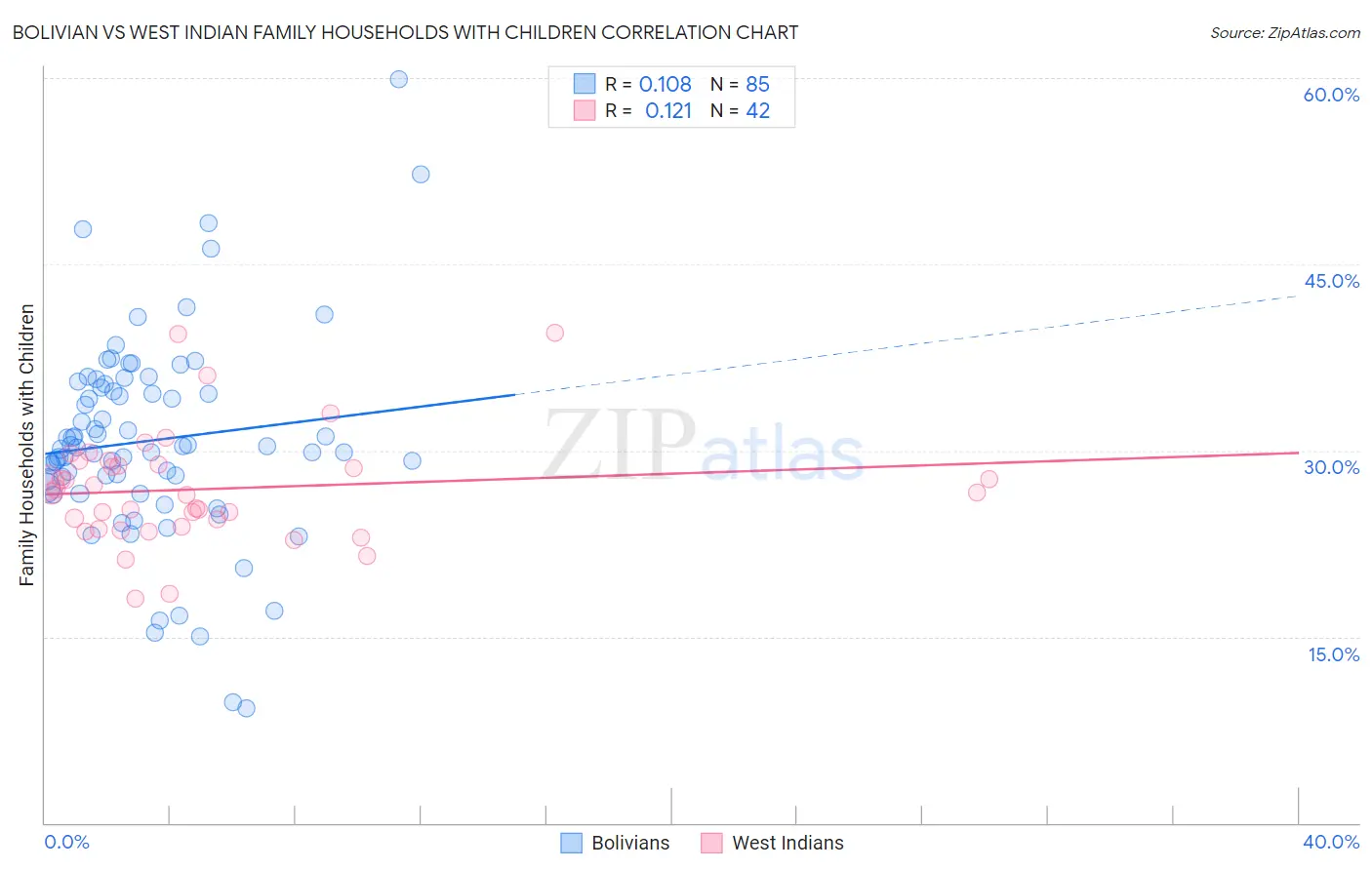Bolivian vs West Indian Family Households with Children
COMPARE
Bolivian
West Indian
Family Households with Children
Family Households with Children Comparison
Bolivians
West Indians
29.5%
FAMILY HOUSEHOLDS WITH CHILDREN
100.0/ 100
METRIC RATING
29th/ 347
METRIC RANK
26.3%
FAMILY HOUSEHOLDS WITH CHILDREN
0.0/ 100
METRIC RATING
307th/ 347
METRIC RANK
Bolivian vs West Indian Family Households with Children Correlation Chart
The statistical analysis conducted on geographies consisting of 184,562,629 people shows a poor positive correlation between the proportion of Bolivians and percentage of family households with children in the United States with a correlation coefficient (R) of 0.108 and weighted average of 29.5%. Similarly, the statistical analysis conducted on geographies consisting of 253,803,119 people shows a poor positive correlation between the proportion of West Indians and percentage of family households with children in the United States with a correlation coefficient (R) of 0.121 and weighted average of 26.3%, a difference of 12.2%.

Family Households with Children Correlation Summary
| Measurement | Bolivian | West Indian |
| Minimum | 9.2% | 18.0% |
| Maximum | 59.9% | 39.5% |
| Range | 50.7% | 21.5% |
| Mean | 30.8% | 26.9% |
| Median | 30.3% | 26.5% |
| Interquartile 25% (IQ1) | 27.3% | 23.9% |
| Interquartile 75% (IQ3) | 35.2% | 28.9% |
| Interquartile Range (IQR) | 7.8% | 5.0% |
| Standard Deviation (Sample) | 8.2% | 4.5% |
| Standard Deviation (Population) | 8.2% | 4.5% |
Similar Demographics by Family Households with Children
Demographics Similar to Bolivians by Family Households with Children
In terms of family households with children, the demographic groups most similar to Bolivians are Samoan (29.5%, a difference of 0.0%), Yuman (29.5%, a difference of 0.030%), Immigrants from Vietnam (29.5%, a difference of 0.16%), Japanese (29.4%, a difference of 0.18%), and Sri Lankan (29.5%, a difference of 0.19%).
| Demographics | Rating | Rank | Family Households with Children |
| Malaysians | 100.0 /100 | #22 | Exceptional 29.8% |
| Mexican American Indians | 100.0 /100 | #23 | Exceptional 29.7% |
| Guamanians/Chamorros | 100.0 /100 | #24 | Exceptional 29.7% |
| Immigrants | Latin America | 100.0 /100 | #25 | Exceptional 29.7% |
| Sri Lankans | 100.0 /100 | #26 | Exceptional 29.5% |
| Immigrants | Vietnam | 100.0 /100 | #27 | Exceptional 29.5% |
| Samoans | 100.0 /100 | #28 | Exceptional 29.5% |
| Bolivians | 100.0 /100 | #29 | Exceptional 29.5% |
| Yuman | 100.0 /100 | #30 | Exceptional 29.5% |
| Japanese | 100.0 /100 | #31 | Exceptional 29.4% |
| Immigrants | Yemen | 100.0 /100 | #32 | Exceptional 29.4% |
| Venezuelans | 100.0 /100 | #33 | Exceptional 29.4% |
| Immigrants | Bolivia | 100.0 /100 | #34 | Exceptional 29.3% |
| Immigrants | Sierra Leone | 100.0 /100 | #35 | Exceptional 29.3% |
| Immigrants | Venezuela | 100.0 /100 | #36 | Exceptional 29.3% |
Demographics Similar to West Indians by Family Households with Children
In terms of family households with children, the demographic groups most similar to West Indians are Lumbee (26.3%, a difference of 0.020%), Bermudan (26.3%, a difference of 0.080%), Guyanese (26.3%, a difference of 0.10%), Immigrants from Bahamas (26.3%, a difference of 0.12%), and Immigrants from Somalia (26.3%, a difference of 0.13%).
| Demographics | Rating | Rank | Family Households with Children |
| Paiute | 0.1 /100 | #300 | Tragic 26.4% |
| Immigrants | Trinidad and Tobago | 0.1 /100 | #301 | Tragic 26.4% |
| Serbians | 0.1 /100 | #302 | Tragic 26.4% |
| Immigrants | Guyana | 0.1 /100 | #303 | Tragic 26.3% |
| Immigrants | Bahamas | 0.1 /100 | #304 | Tragic 26.3% |
| Guyanese | 0.1 /100 | #305 | Tragic 26.3% |
| Bermudans | 0.1 /100 | #306 | Tragic 26.3% |
| West Indians | 0.0 /100 | #307 | Tragic 26.3% |
| Lumbee | 0.0 /100 | #308 | Tragic 26.3% |
| Immigrants | Somalia | 0.0 /100 | #309 | Tragic 26.3% |
| Marshallese | 0.0 /100 | #310 | Tragic 26.2% |
| Colville | 0.0 /100 | #311 | Tragic 26.2% |
| Immigrants | Czechoslovakia | 0.0 /100 | #312 | Tragic 26.2% |
| Cree | 0.0 /100 | #313 | Tragic 26.2% |
| French Canadians | 0.0 /100 | #314 | Tragic 26.1% |